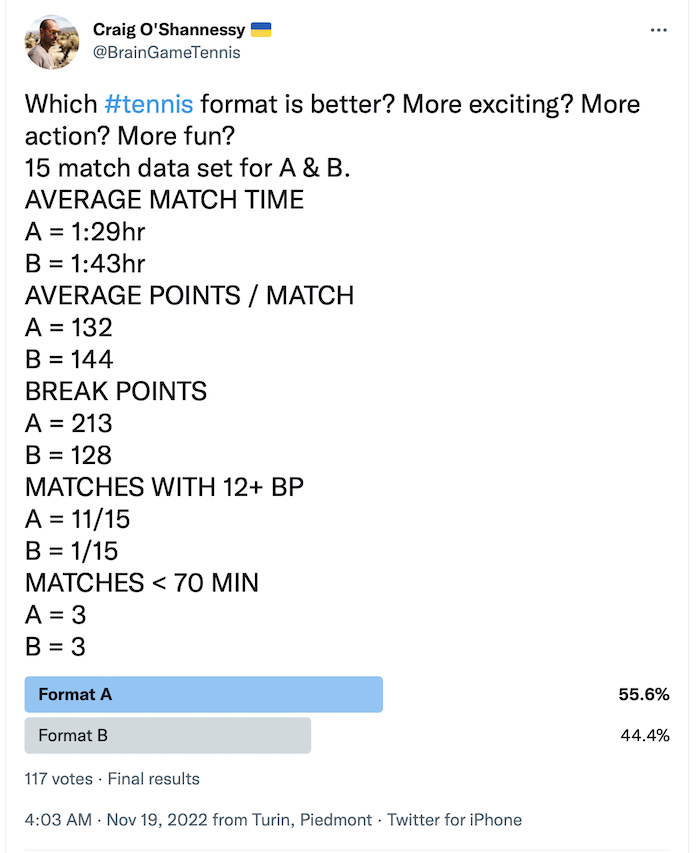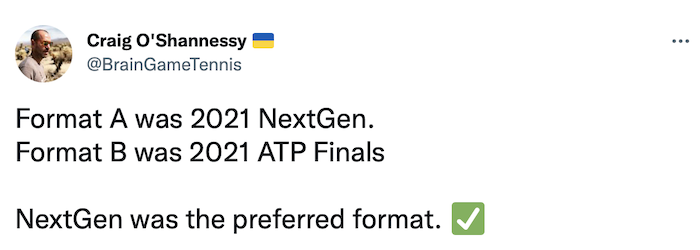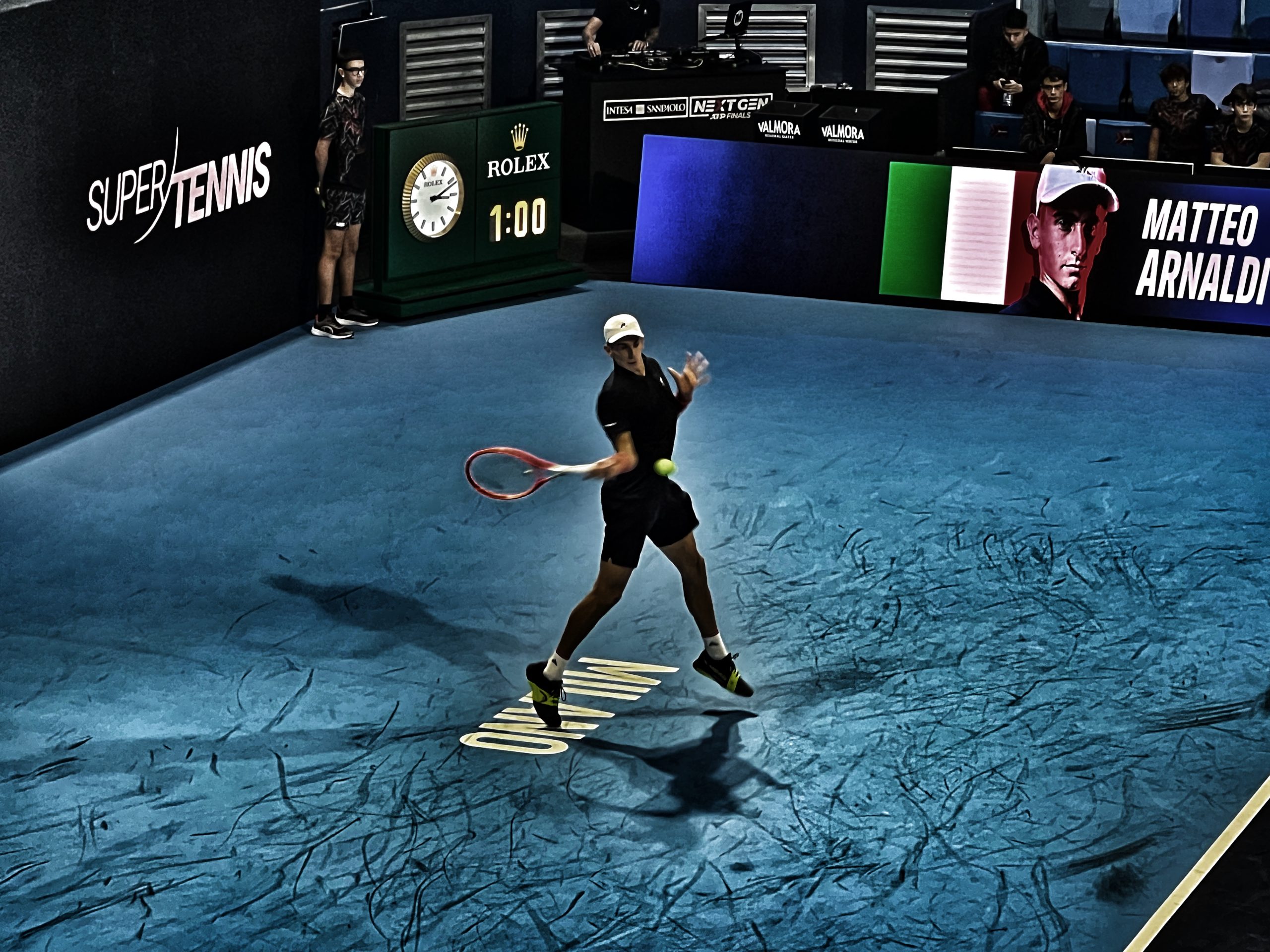TWITTER: November, 2022

TWITTER: WHICH FORMAT WON?

Want to improve tennis?
Update. The. Scoring. System.
Change it to make tennis a more exciting product. Change it to have a more predictable and more appealing average match time. Change it to help lower-level tournaments attract more fans & become financially viable. Change it to better face the global onslaught from Pickleball, Padel, and Beach Tennis. Change it because it is a more exciting format.
Before you jump out of your seat and lose your ever-loving mind, I want you to hold my hand and let me walk you through a head-to-head comparison between the 2021 editions of NextGen and ATP Finals. Both tournaments had the exact same round-robin format starting with two groups of four players that migrated into a knockout semi-final format. Both formats had 15 matches.
Disclaimer: I attended the NextGen and ATP Finals last year and this year in Milan and Torino. I sat on the side of the court (great seats, thank you, Federation Italian Tennis) for almost every match. I experienced the two scoring formats first-hand, and there really is no comparison at the end of the day.
NEXTGEN FORMAT
The NextGen plays first to four games, No Ad, best of five sets. A seven-point tie-break was played at three games all in each set.
ATP Finals FORMAT
Best two out of three set format. Same as it ever was.
WHY CHANGE?
Let’s start with this quote from Heraclitus.
“The only constant in life is change.”
I am advocating for change because I think the alternative has many improvements over the traditional format.
NEXTGEN vs. ATP Finals
I collected data in seven specific areas. Let’s go through them one by one.
1: Maximum Points Played In A Match
- 217 points NEXTGEN – Musetti def. Gaston 4-3(4), 4-3(6), 2-4, 3-4(7), 4-2
- 216 points ATP FINALS – Medvedev def. Zverev 6-3, 6-7(3), 7-6(6)
So the first argument against the NextGen scoring is that there simply isn’t enough tennis played when you compete first to four, best of five sets. That’s simply not true. The longest match at NEXTGEN was 217 points. The longest match at the ATP Finals was 216 points. So they can both go long.
2: Average Match Time
- NEXTGEN = 1 hour & 29 minutes.
- ATPFINALS = 1 hour & 43 minutes
- Difference = 14 minutes
The NEXTGEN scoring system came in right at an hour and a half on average for the matches. If you are the broadcaster, that’s a far more appealing number than having a match go 14 minutes longer at 1:43.
3: Average Points Per Match
- NEXTGEN = 132 points per match
- ATP FINALS = 144 points per match
- Difference = 12 points per match
The NEXTGEN format generated, on average, 12 fewer points per match. So when you link this data point with the one above (Average Match Time), you see that, on average, you are playing 12 extra points in a 14-minute period. That’s not a lot of points in that amount of time. That’s some pretty slow tennis.
4: Matches Lasting Less Than 70 Minutes
- NEXTGEN = 3 matches
- ATPFINALS = 3 matches
Now, let’s go look at short matches. You would think that NEXTGEN would have significantly more short matches, but it’s not true. Really short matches can be defined as lasting 70 minutes of less. Both formats had three matches here.
5: Break Points Generated
- NEXTGEN = 213 break points (62%)
- ATPFINALS = 128 break points (38%)
- Difference = 85 break points
This is where the rubber meets the road between the two formats. There is nothing more exciting, more compelling in a tennis match than the excitement of break points. If you are a fan, you are absolutely putting your iPhone down and watching these “king-maker” points that ultimately decide the outcome of the match. The NEXTGEN format accounted for 62% of all break points between the two tournaments. It’s night and day, really. NEXTGEN is a vastly superior format when it comes to the exciting times in a game.
6: Matches Generating 12+ Break Points
- NEXTGEN = 11/15 matches
- ATPFINALS = 1/15 break point
This is another very one-sided stat that greatly favors the NEXTGEN format. Watching 12 or more break points in a match is going to keep the fans engaged, whether they are sitting court-side or watching on television. The NEXTGEN format had 73% (11/15) of it’s matches containing 12+ break points. The ATP Finals had only 7% (1/15). One format is vastly superior to creating excitement in a match.
7: Tie-Breaks
- NEXTGEN = 20 tie-breaks
- ATPFINALS = 9 tie-breaks
Tie-breaks are high energy and command a lot of attention from the fans. The fact that the NEXTGEN format had more than double that of the ATP Finals is yet another nail in the coffin for the traditional format.
SUMMARY
Playing first to four, No Ad, over five sets is a valid scoring system for our sport. I think you can see above that it definitely creates more exciting moments in a match. So this is how I think it should be rolled out.
- Grand Slam Events – stay the same. Best of five sets.
- Masters 1000 & ATP 500 events – stay the same. Best of three sets.
- ATP 250 events & lower – An ideal place to introduce the NEXTGEN format.
ATP 250 tournaments and Challenger level events all too often struggle financially. It’s not easy to make a living for the player or the tournament at this entry level to the Top 100 in the world. As you can clearly see above, the NEXTGEN format provides more excitement for the fans. It provides more big points, more tie-breaks and more energy.
Let’s face it… the traditional set to six has a lot of dead time at the start of the match. I was courtside for Rafael Nadal vs. Casper Ruud earlier this week in Torino. Nadal won 7-5, 7-5. Until each set reached 5-5, there were A LOT of people around me on their iPhones scrolling social media. Once the match reached 5-5 and got interesting, they finally put their phones down.
I think there is plenty of room in our sport to play different formats. We are already doing it with best of three sets vs. best of five sets. At one stage, we didn’t play tie-breaks. Thank goodness we do now.
I invite you to open your mind to expanding the NEXTGEN format. Why don’t you incorporate it into your own practices and see for yourself what it is like. I look forward to your review!
All the best from Torino,
Craig

